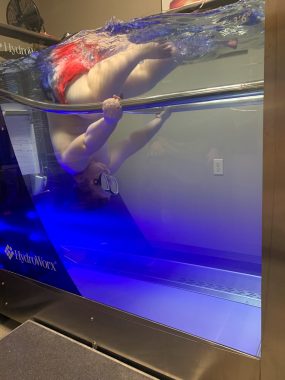Why Pool Therapy Is Part of Our Care Plan

I write my columns on Tuesdays. I do this because I procrastinate. My deadline is Wednesday morning, and I’m not about to wake up early on Wednesdays to get it done. I am not a morning person, but I’m too old and have too many kids to stay up late writing it. I should write it on Mondays because I’m busy with pool therapy on Tuesdays.
Not personally. I never get in the water. But I take Charlie, my 11-year-old son, to pool therapy at 8 a.m. and then to school before I go home to write my column and hopefully finish it before I pick up Rowen, my 13-year-old, from school at 2 p.m. and take him to pool therapy. My 16-year-old, Max, goes on Friday after school.
These times work best for the boys and their school schedules. Charlie and Rowen, who go to Catholic schools, miss the school Mass but do not miss class. Max, an active high school student, can’t afford to miss school and goes after it’s over.
The three therapy appointments each week make for a busy schedule, but I wouldn’t change anything. I would do it if I had to drive an hour to get the boys in a pool. I think pool or aquatic therapy should be standard care for boys with Duchenne muscular dystrophy (DMD). I believe it is crucial for our nonambulatory boys.
We had a rocky start with pool therapy 10 years ago when we started our DMD journey. The only pool available was at our local YMCA, and our oldest son, Max, thought the water was cold and did not enjoy it. Each week it became such a fight to get him in the pool that we stopped the therapy. A few years passed, and updates to the pool and boys who were a little older encouraged us to try again. It was much more successful.
At the beginning of the pandemic, we stopped therapy again. However, when our middle son, Rowen, fell and broke his leg, it was vital to get him back on his feet, even while the bone was healing. So we started going to a new physical therapy office where they had recently installed a HydroWorx, which is a free-standing pool unit with a treadmill. We loved it immediately, and before long, we started taking all three of our boys to use it.
I love this pool for a few reasons. It is always warm. The water height is adjustable. It has therapy jets, in addition to the treadmill. And finally, we can transfer my nonambulatory son, Rowen, into and out of the unit.
Because the pool allows the boys to take advantage of their buoyancy in the water, it reduces the stress on their muscles and joints. Of course, this is true for everyone, but I think the benefits for those with Duchenne are even more significant.
For example, my boys have maintained lung function, if not increased their capacity. The boys go to individual appointments, but all work on holding their breath. My family is very competitive, and the boys have the therapist time them and keep track of who holds their breath the longest. I would never admit it to them, but it’s Rowen. He crushes the competition.
Therapy in the water also allows them to walk with a normal gait and do many things they can’t do on land. So not only is it fun for them, but it also does my heart good to watch them moving so easily.
My boys are the youngest patients, but they are also the patients who have the most fun. They bring their goggles and are underwater, playing and doing flips as much as they walk.
Rowen loves the TV show “American Ninja Warrior.” He has created a ninja warrior obstacle course of sorts that he goes through each week and times himself, always trying to beat his record.
Another benefit I’ve seen is increased flexibility. Since we started taking the boys weekly, they are so much more flexible when we do their home stretches. It has also helped with pain management. Rowen is my only son who complains of leg pain, usually after a long day in his power wheelchair, but in the water he has an opportunity to stand, bear weight, and stretch his hip flexors. He finds so much relief.
I feel like I’m always learning with Duchenne. One thing I’m glad I figured out is how much water therapy has helped my sons. In a world where Duchenne makes life anything but predictable, I foresee pool therapy as always being part of my sons’ care plans.

Columnist Betty Vertin’s son Rowen does flips during pool therapy on April 26. (Courtesy of Betty Vertin)
Note: Muscular Dystrophy News is strictly a news and information website about the disease. It does not provide medical advice, diagnosis or treatment. This content is not intended to be a substitute for professional medical advice, diagnosis, or treatment. Always seek the advice of your physician or another qualified health provider with any questions you may have regarding a medical condition. Never disregard professional medical advice or delay in seeking it because of something you have read on this website. The opinions expressed in this column are not those of Muscular Dystrophy News or its parent company, Bionews, and are intended to spark discussion about issues pertaining to muscular dystrophy.








Lizel Katzberg
Love this, Betty. I have wondered about swim therapy, but haven't read or heard many people talk about it! We have an outdoor in-the-groud pool with a swim jet, and my parents across the street have a small indoor year-round pool with swim jet. We would love to incorporate swim therapy in the future, and this was just the encouragement I needed. Fun to meet your family at the ball field last week. :)
Betty Vertin
It was great to meet you, too! We also have a pool in the backyard and love the extra water time they get when the weather is warm! How nice to have your parents indoor pool so close!
Bruce E Hermesch
I'm 57 and have FSHD, I've been doing Water Therapy for 3 1/2 years, and I believe it's the only reason I can still walk at all. I would highly recommend it.
Betty Vertin
Thank you for sharing. I love the all the benefits of pool therapy!